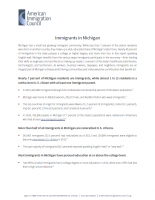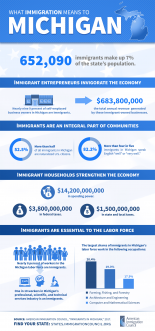- Fact Sheet
Immigrants in Michigan
Published
Michigan has a small but growing immigrant community. About 7 percent of the state’s residents were born in another country and they make up a vital, educated share of Michigan’s labor force. More than 40 percent of immigrants in the state possess a college or higher degree, and more than four in five report speaking English well.
Michigan benefits from the various ways immigrants participate in the economy—from lending their skills as engineers and architects to making up one in ten of the state’s healthcare practitioners, technologists, and technicians. As neighbors, business owners, taxpayers, and workers, immigrants are an integral part of Michigan’s diverse and thriving communities and make extensive contributions that benefit all.
Seven percent of Michigan residents are immigrants, while another 7 percent of residents are native-born U.S. citizens with at least one immigrant parent.
- In 2018, 695,217 immigrants (foreign-born individuals) comprised 7 percent of the population.
- Michigan was home to 324,461 women, 319,387 men, and 51,369 children who were immigrants.
- The top countries of origin for immigrants were Mexico (13 percent of immigrants), India (11 percent), Iraq (10 percent), China (5 percent), and Canada (5 percent).
- In 2018, 686,382 people in Michigan (7 percent of the state’s population) were native-born Americans who had at least one immigrant parent.
More than half of all immigrants in Michigan are naturalized U.S. citizens.
- 372,793 immigrants (54 percent) had naturalized as of 2018, and 120,680 immigrants were eligible to become naturalized U.S. citizens in 2017.
- More than four in five (83 percent) immigrants reported speaking English “well” or “very well.”
Most immigrants in Michigan have pursued education at or above the college level.
- More than two in five (43 percent) adult immigrants had a college degree or more education in 2018, while one in five (20 percent) had less than a high school diploma.
|
Education Level |
Share (%) of All Immigrants |
Share (%) of All Natives |
|---|---|---|
|
College degree or more |
43 |
28 |
|
Some college |
18 |
34 |
|
High school diploma only |
19 |
30 |
|
Less than a high school diploma |
20 |
8 |
|
Source: U.S. Census Bureau, 2018 American Community Survey 1-Year Estimates. |
||
Almost 72,000 U.S. citizens in Michigan live with at least one family member who is undocumented.
- 100,000 undocumented immigrants comprised 15 percent of the immigrant population and 1 percent of the total state population in 2016.
- 157,529 people in Michigan, including 71,643 U.S. citizens, lived with at least one undocumented family member between 2010 and 2014.
- During the same period, about 2 percent of children in the state were U.S. citizens living with at least one undocumented family member (52,748 children in total).
Michigan is home to thousands of Deferred Action for Childhood Arrivals (DACA) recipients.
- 5,250 active DACA recipients lived in Michigan as of March 2020, while DACA has been granted to 6,443 people in total since 2012.
- As of 2019, 41 percent of DACA-eligible immigrants in Michigan had applied for DACA.
- An additional 3,000 residents of the state would satisfy all but the educational requirements for DACA, and fewer than 1,000 would become eligible as they grew older.
Immigrants make up 8 percent of the labor force in Michigan and are integral to a range of industries.
- 403,871 immigrant workers comprised 8 percent of the labor force in 2018.
- Immigrant workers were most numerous in the following industries:
|
Industry |
Number of Immigrant Workers |
|---|---|
|
Manufacturing |
113,291 |
|
Health Care and Social Assistance |
61,475 |
|
Accommodation and Food Services |
43,685 |
|
Educational Services |
41,476 |
|
Retail Trade |
40,949 |
|
Source: Analysis of the U.S. Census Bureau’s 2018 American Community Survey 1-year PUMS data by the American Immigration Council. |
|
- The largest shares of immigrant workers were in the following industries:
|
Industry |
Immigrant Share (%) |
|---|---|
|
Manufacturing |
11 |
|
Agriculture, Forestry, Fishing, and Hunting |
10 |
|
Professional, Scientific, and Technical Services |
9 |
|
Accommodation and Food Services |
9 |
|
Transportation and Warehousing |
8 |
|
Source: Analysis of the U.S. Census Bureau’s 2018 American Community Survey 1-year PUMS data by the American Immigration Council. |
|
Immigrants are an integral part of the Michigan workforce in a range of occupations.
- In 2018, immigrant workers were most numerous in the following occupation groups:
|
Occupation Category |
Number of Immigrant Workers |
|---|---|
|
Production |
44,226 |
|
Management |
42,200 |
|
Sales and Related |
40,372 |
|
Healthcare Practitioners and Technical |
36,262 |
|
Transportation and Material Moving |
34,791 |
|
Source: Analysis of the U.S. Census Bureau’s 2018 American Community Survey 1-year PUMS data by the American Immigration Council. |
|
- The largest shares of immigrant workers were in the following occupation groups:
|
Occupation Category |
Immigrant Share (%) |
|---|---|
|
Architecture and Engineering |
19 |
|
Farming, Fishing, and Forestry |
19 |
|
Computer and Mathematical |
16 |
|
Life, Physical, and Social Science |
14 |
|
Healthcare Practitioners and Technical |
10 |
|
Source: Analysis of the U.S. Census Bureau’s 2018 American Community Survey 1-year PUMS data by the American Immigration Council. |
|
- Undocumented immigrants comprised 1 percent of Michigan’s workforce in 2016.
Immigrants in Michigan have contributed billions of dollars in taxes.
- Immigrant-led households in the state paid $5 billion in federal taxes and $2.1 billion in state and local taxes in 2018.
- Undocumented immigrants in Michigan paid an estimated $317.1 million in federal taxes and $143.5 million in state and local taxes in 2018.
- Michigan DACA recipients and DACA-eligible individuals paid an estimated $13.4 million in state and local taxes in 2018.
As consumers, immigrants add billions of dollars to Michigan’s economy.
- Michigan residents in immigrant-led households had $18.4 billion in spending power (after-tax income) in 2018.
Immigrant entrepreneurs in Michigan generate over a half-billion dollars in business revenue.
- 37,419 immigrant business owners accounted for 9 percent of all self-employed Michigan residents in 2018 and generated $731.5 million in business income.
- In 2018, one in seven (15 percent) business owners was an immigrant in the in the Detroit/Warren/Livonia metropolitan area.


